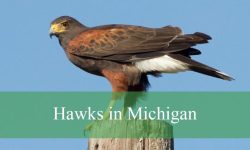Falcons are some of the most awe-inspiring birds of prey found across Michigan. Known for their incredible speed, sharp eyesight, and precise hunting skills, these raptors have fascinated birdwatchers and nature lovers for centuries. Whether soaring high above city skylines or darting swiftly through open fields, falcons play a vital role in maintaining the balance of local ecosystems.
Michigan’s diverse landscapes—from dense forests and wetlands to sprawling urban areas—provide ideal habitats for several falcon species. Each type of falcon brings its own unique behaviors, physical traits, and hunting styles that make them stand out. Learning to identify these birds can be a thrilling experience for both amateur and seasoned birdwatchers.
In this guide, we’ll explore six remarkable falcon species that call Michigan home. From the speedy Peregrine Falcon to the colorful American Kestrel, you’ll discover detailed information about their appearance, habits, habitats, and fascinating facts that highlight their importance in Michigan’s natural world.
Overview of Falcons in Michigan
Michigan’s varied environment offers a welcoming home to a fascinating array of falcon species. These birds of prey, renowned for their remarkable hunting abilities and aerodynamic bodies, have adapted well to the state’s mix of urban, suburban, and wild habitats. Falcons play a crucial role in controlling populations of smaller birds, insects, and rodents, contributing to a healthy and balanced ecosystem.
The falcon species found in Michigan range from the widely distributed American Kestrel—the smallest and most colorful falcon in North America—to the powerful Peregrine Falcon, known for its breathtaking speed and agility. Other species, such as the Merlin and the rare Gyrfalcon, add to the diversity, reflecting Michigan’s position as a crossroads for migratory raptors.
Many falcons in Michigan have experienced population challenges in the past, particularly due to habitat loss and pesticide use. However, focused conservation efforts, including habitat protection and breeding programs, have resulted in significant recoveries, especially for species like the Peregrine Falcon. Today, these falcons can be observed in a variety of settings—from bustling cityscapes to quiet rural areas—offering ample opportunities for birdwatchers and wildlife enthusiasts to appreciate their beauty and impressive skills.
Peregrine Falcon (Falco peregrinus)
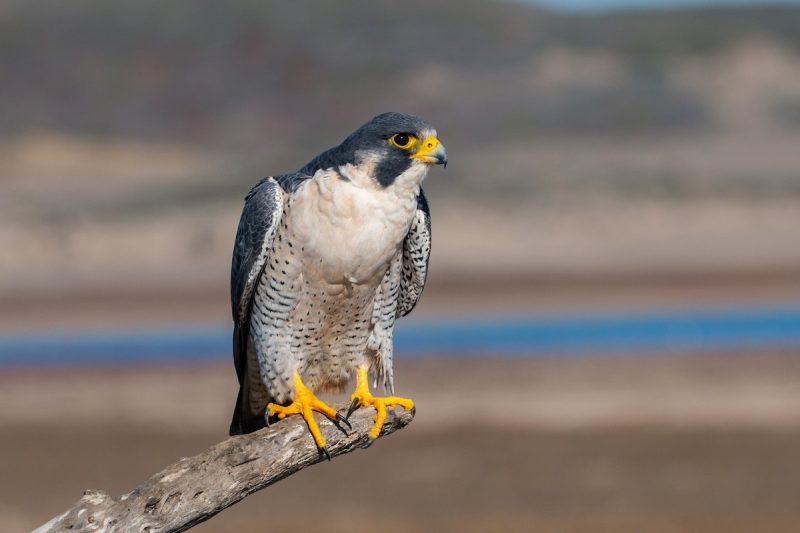
Identification and Physical Characteristics
The Peregrine Falcon is a medium-sized raptor, renowned for its aerodynamic shape and stunning hunting speed. Adults measure roughly 14 to 19 inches (35–49 cm) in length, with a wingspan between 3.3 to 3.6 feet (1 to 1.1 meters). Their streamlined body is perfect for high-velocity flight. The upperparts are a striking slate-blue or blue-gray, while the underparts are predominantly white with fine dark barring. One of the most identifiable features is the distinctive black “moustache” mark on each side of the face, also called a malar stripe, which contrasts with the white throat and cheeks.
Juvenile Peregrines look quite different; their backs are brownish rather than gray, and their underparts are streaked instead of barred, which can sometimes cause confusion with other raptors. Both sexes look similar, though females are generally larger, sometimes almost 30% heavier than males.
Behavior and Hunting Style
Peregrine Falcons are apex aerial predators. They hunt by soaring high and spotting prey with their exceptional vision from hundreds of feet in the air. Their signature hunting method is the stoop—a dramatic, high-speed dive during which they tuck their wings and accelerate toward their prey. Speeds during a stoop have been recorded at over 200 mph (320 km/h), making them the fastest birds on Earth.
Their prey mostly consists of medium-sized birds such as pigeons, doves, waterfowl, and songbirds, which they often strike mid-air with a powerful blow from their talons. Peregrines are also known to hunt bats during dawn and dusk.
During breeding season, these falcons fiercely defend nesting sites that are usually located on tall cliffs in wild areas or on ledges of skyscrapers and bridges in urban environments. Both parents share incubation and feeding duties, and the chicks fledge about five to six weeks after hatching.
Habitat and Distribution in Michigan
Historically, Peregrine Falcons were heavily affected by pesticide poisoning, especially DDT, which caused dramatic declines in their population. Since the 1970s, conservation programs, including captive breeding and banning harmful pesticides, have helped their numbers rebound. Today, Michigan hosts a thriving population of Peregrine Falcons.
In Michigan, Peregrines are often found near major cities such as Detroit, Grand Rapids, and Lansing, where tall buildings provide excellent nesting opportunities similar to natural cliff faces. They also occupy river valleys and shorelines with abundant prey. During migration, Peregrines pass through various habitats across the state, including forests and wetlands.
Fun Fact
Peregrine Falcons possess one of the highest oxygen intake rates among birds, allowing them to sustain their incredibly fast stoop dives without blacking out. This physiological adaptation is critical for their hunting success.
American Kestrel (Falco sparverius)
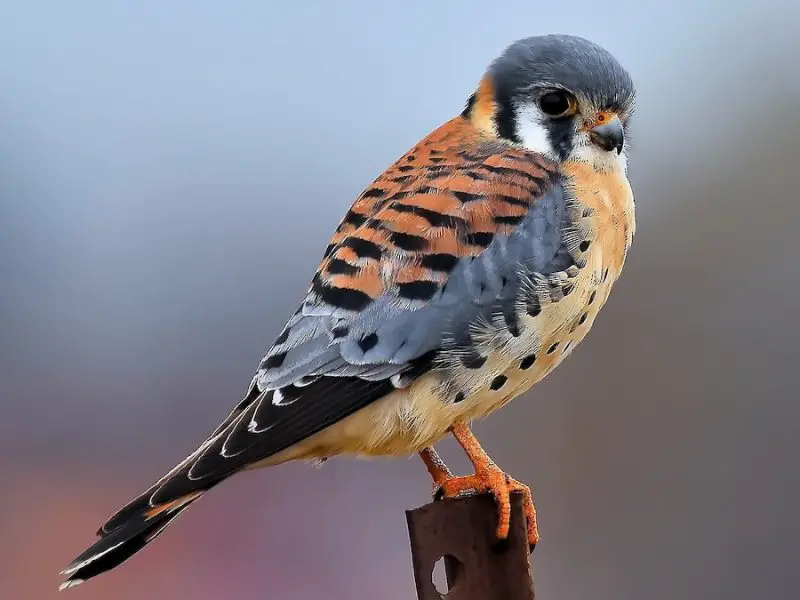
Identification and Physical Characteristics
The American Kestrel is the smallest falcon in Michigan and one of the most colorful raptors in North America. Adults range from 9 to 12 inches (23–30 cm) in length, with a wingspan between 20 to 24 inches (50–61 cm). Males and females differ in plumage, a trait known as sexual dimorphism.
Males boast blue-gray wings, a rusty red back and tail with a black subterminal band near the tail tip, and a white face marked with two distinct black vertical stripes framing the eyes. Females have reddish-brown wings with heavy black barring and less vibrant coloration overall. Both sexes have sharp, hooked beaks and long tails, enhancing their maneuverability in flight.
Juveniles look similar to adult females but with more muted tones.
Behavior and Hunting Style
American Kestrels hunt primarily by hovering—flapping their wings rapidly while maintaining a stationary position—to scan for prey below. Once spotted, they swoop down swiftly to capture insects, small mammals like mice, reptiles, and small birds. They often use perches such as telephone wires, fence posts, and tree branches as hunting vantage points.
Unlike many falcon species, kestrels nest in cavities rather than open nests. They rely heavily on tree holes, old woodpecker nests, and increasingly on human-provided nest boxes. Both male and female share incubation and chick-feeding duties.
American Kestrels are active throughout the day and known for their vibrant calls, a repeated “klee-klee-klee,” that can be heard during flight or territorial disputes.
Habitat and Distribution in Michigan
This adaptable falcon is widespread throughout Michigan, inhabiting open areas such as fields, meadows, parks, and suburban neighborhoods. In southern Michigan, kestrels can be residents year-round, while northern populations tend to migrate southward in winter.
Their success is partly due to their ability to thrive in human-altered landscapes where hunting grounds are plentiful. Kestrels contribute significantly to controlling insect and rodent populations, making them important in both natural and agricultural ecosystems.
Fun Fact
American Kestrels can see ultraviolet light, which helps them detect the urine trails of small mammals, effectively revealing prey locations invisible to many other predators.
Merlin (Falco columbarius)
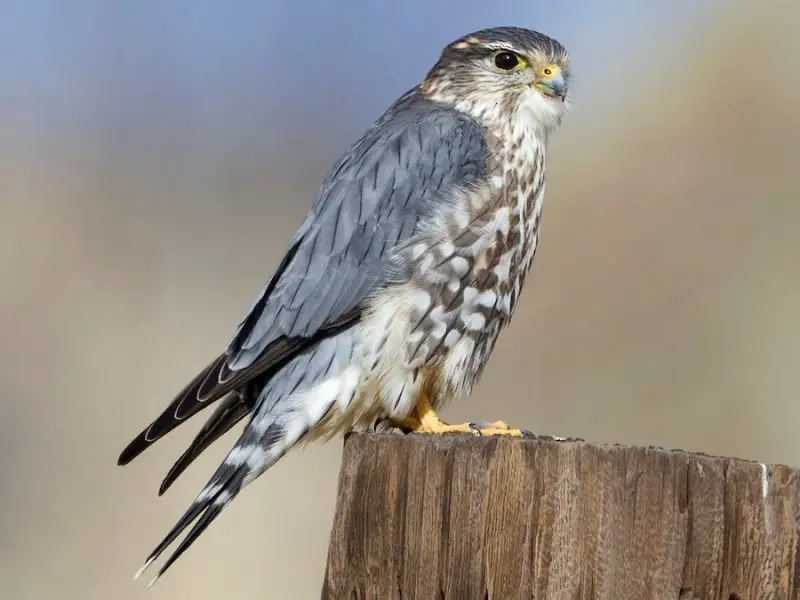
Identification and Physical Characteristics
Merlins are robust, stocky falcons measuring approximately 9 to 13 inches (23–33 cm) long, with wingspans ranging from 20 to 27 inches (51–69 cm). Their compact shape gives them a powerful and muscular look.
The plumage of Merlins varies but generally consists of dark brown or slate-gray upperparts and heavily streaked underparts that range from cream to buff. They lack the prominent facial markings of kestrels but may have faint malar stripes. Their tails are relatively short with narrow bands.
There are two main color morphs: the “dark phase,” common in the northern US, has uniformly dark plumage, while the “light phase” is paler and more streaked.
Behavior and Hunting Style
Merlins are fierce, fast-flying predators that pursue small birds with relentless chases, often in wooded or shrubby environments. Their hunting style is aggressive, involving rapid pursuit, sudden twists, and surprise attacks. Unlike kestrels, Merlins rarely hover and instead rely on speed and surprise.
During the breeding season, Merlins are territorial and nest in tree cavities, abandoned hawk nests, or cliff ledges. Both parents participate in raising the young, which fledge in about a month.
Merlins are known for their harsh, rasping calls that differ markedly from the softer kestrel vocalizations.
Habitat and Distribution in Michigan
Merlins breed primarily in Michigan’s northern forests and boreal habitats. During migration and winter, they disperse southward and can be found in a variety of habitats including coastal regions, woodlots, and open fields.
Their presence in southern Michigan is more common during the colder months, when they prey on migratory songbirds congregating at feeders and open fields.
Fun Fact
Merlins are sometimes called “pigeon hawks” because they are strong enough to capture birds the size of pigeons, though their diet usually consists of smaller birds.
Gyrfalcon (Falco rusticolus)
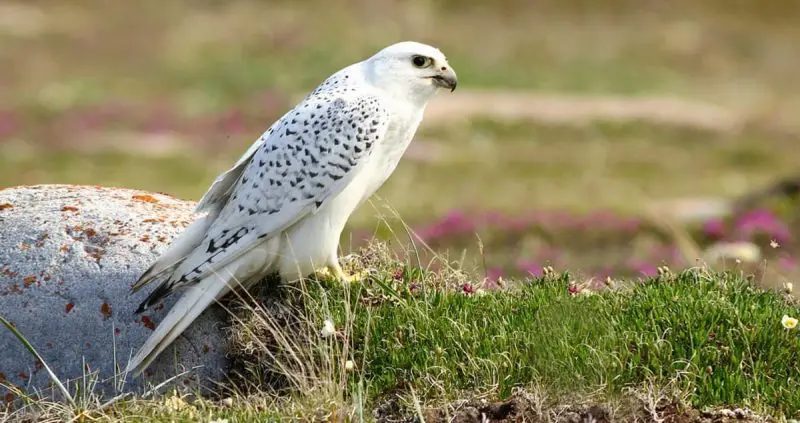
Identification and Physical Characteristics
Gyrfalcons are the largest falcon species in North America, rivaling some hawks in size. They measure between 19 and 26 inches (48–66 cm) in length, with wingspans reaching nearly 4 feet (1.2 meters). They exhibit a wide range of plumage color morphs—from nearly pure white to dark gray or black—with various mottled patterns that offer camouflage in Arctic and tundra environments.
Their bodies are powerful and bulky, with thick legs and large talons built for subduing prey. The tail is broad and rounded, aiding in maneuverability during flight.
Behavior and Hunting Style
Gyrfalcons are apex predators in their northern range, hunting a variety of birds such as ptarmigans, waterfowl, and seabirds, as well as mammals like hares. They pursue prey with fast, direct flight and can also hunt from perch ambush.
Unlike many falcons, Gyrfalcons sometimes scavenge carrion, a behavior that helps them survive in harsh environments where prey can be scarce.
Nesting sites are typically on cliff ledges or rocky outcrops. Both sexes defend large territories during breeding season, and pairs often mate for life.
Habitat and Distribution in Michigan
Gyrfalcons are considered rare visitors to Michigan, mainly seen during winter irruptions when food shortages in their Arctic breeding grounds push them south. These sightings are exciting and attract birders keen on observing this impressive falcon far outside its typical range.
When present, they prefer open landscapes such as shorelines, agricultural fields, and open woodlands where prey availability is highest.
Fun Fact
Historically, Gyrfalcons were highly prized by medieval falconers, especially in Europe, for their size, strength, and hunting prowess. They remain symbols of power and nobility.
Crested Caracara (Caracara cheriway)
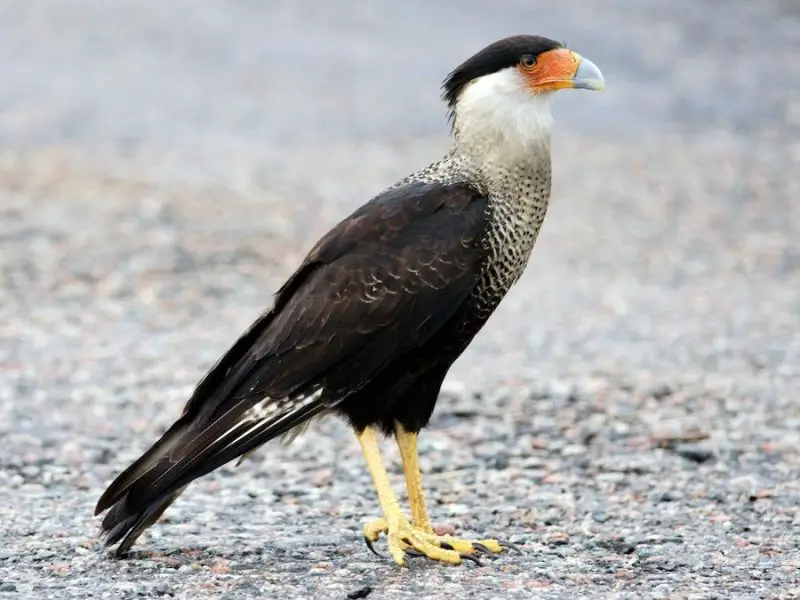
Identification and Physical Characteristics
The Crested Caracara is a unique member of the falcon family, though it looks more like a large crow or vulture. Adults measure about 20 to 24 inches (51–61 cm) in length, with a wingspan that can exceed 4 feet (1.3 meters). They have a distinctive black cap or crest, bright orange-red face skin, a white neck and throat, and a chestnut-brown body with broad wings marked by white patches.
Their long legs are adapted for walking on the ground, a trait uncommon among falcons.
Behavior and Hunting Style
Unlike many falcons that hunt primarily by aerial pursuit, Crested Caracaras are opportunistic feeders. They often scavenge carrion and are known to steal food from other birds. They forage on foot in open habitats, using their strong legs to walk and search for insects, reptiles, small mammals, and eggs.
They are social birds, often seen in pairs or small groups. Their vocalizations are loud and harsh, consisting of cackling calls.
Habitat and Distribution in Michigan
Crested Caracaras are rare vagrants in Michigan, usually spotted only during unusual weather events that bring them far from their usual range in the southern US, Mexico, and Central America. They prefer open, grassy, or scrubby areas and are more commonly found in the southernmost parts of Texas and Florida.
Fun Fact
The Crested Caracara is sometimes called the “Mexican eagle” or “Mexican caracara” due to its striking appearance and scavenging behavior, blending traits of both falcons and vultures.
Prairie Falcon (Falco mexicanus)
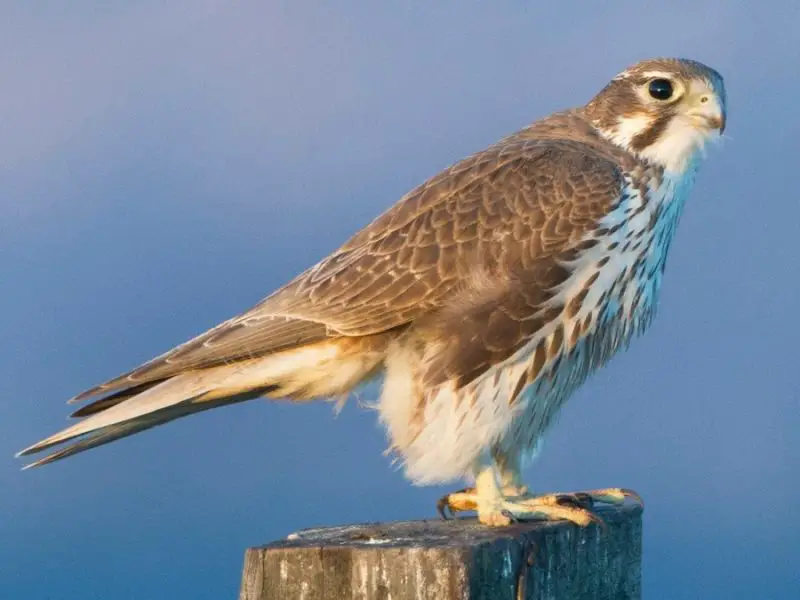
Identification and Physical Characteristics
The Prairie Falcon is a medium-sized falcon measuring between 14 and 19 inches (36–48 cm) long, with a wingspan from 3.3 to 3.6 feet (1 to 1.1 meters). Its sandy-brown coloration and pale underside with brown streaking provide excellent camouflage in open grasslands and desert habitats. The species features subtle facial markings including a dark malar stripe and distinctive dark “armpit” patches visible under the wings during flight.
The tail is long and barred, and wings are pointed and tapered, allowing for fast, agile flight.
Behavior and Hunting Style
Prairie Falcons are agile hunters that chase down prey in open terrain. Their diet mainly includes small birds and mammals such as ground squirrels, rabbits, and prairie dogs. They hunt by fast, low-level pursuit and are known for their endurance and ability to fly long distances during foraging.
Prairie Falcons nest on cliff ledges or rocky outcrops and defend large territories during breeding season. They are known for their boldness and will aggressively defend nests against intruders.
Habitat and Distribution in Michigan
Prairie Falcons are primarily western species, inhabiting grasslands, deserts, and shrublands. However, occasional vagrants reach Michigan, particularly during migration or harsh winters when food scarcity forces them eastward.
These rare appearances provide unique birdwatching opportunities for Michigan residents.
Fun Fact
Prairie Falcons have been observed mimicking the calls of their prey species, a rare trait that may help lure unsuspecting birds closer during hunts.
FAQs about Falcons in Michigan
What are the most common falcons found in Michigan?
The most commonly observed falcons in Michigan are the Peregrine Falcon, American Kestrel, and Merlin. These species adapt well to various habitats, including urban areas, forests, and open fields. The Peregrine Falcon is notable for nesting on tall city buildings, while the American Kestrel is widespread in farmlands and suburban zones.
How can I identify a Peregrine Falcon compared to other falcons?
Peregrine Falcons have a distinctive blue-gray back, barred white underparts, and a prominent black “moustache” mark on their faces. They are medium-sized with long, pointed wings and a streamlined body designed for high-speed stoops. In contrast, American Kestrels are smaller and more colorful, and Merlins have darker, more heavily streaked plumage without the bold facial markings of Peregrines.
Do falcons migrate in Michigan?
Yes, some falcon species in Michigan migrate seasonally. For example, Merlins and American Kestrels tend to migrate southward from northern Michigan during winter months. Peregrine Falcons may also move locally but are more often year-round residents, especially in urban areas. Gyrfalcons and Prairie Falcons are rare visitors mostly seen during winter irruptions or migration events.
Where is the best place to watch falcons in Michigan?
Urban areas with tall buildings, such as Detroit and Grand Rapids, are excellent for spotting Peregrine Falcons nesting on skyscrapers. Open fields, farmlands, and suburban parks provide habitats for American Kestrels. Northern forests and coastal shorelines are prime spots for seeing Merlins, especially during migration. Rare falcons like Gyrfalcons and Prairie Falcons are usually observed in open landscapes during winter months.
What do Michigan falcons eat?
Michigan falcons primarily feed on birds and small mammals. Peregrine Falcons prey on medium-sized birds caught in mid-air. American Kestrels have a more varied diet including insects, small rodents, and birds. Merlins focus mainly on small songbirds, while Gyrfalcons hunt larger birds and mammals. Crested Caracaras are opportunistic and scavenge carrion as well as hunt small animals.
Are any falcon species endangered in Michigan?
The Peregrine Falcon was once endangered due to pesticide impacts but has recovered significantly because of successful conservation programs. Currently, none of the falcon species regularly found in Michigan are listed as endangered. However, habitat protection remains essential to maintain healthy populations.
Can I attract falcons to my backyard in Michigan?
Attracting falcons to a backyard is challenging due to their predatory nature and large territorial ranges. However, providing nest boxes can encourage American Kestrels to breed nearby. Maintaining open spaces and limiting pesticide use can also help support the prey populations falcons rely on.
What time of year is best for falcon watching in Michigan?
Spring and fall migration seasons are ideal for observing a wide variety of falcon species in Michigan, as many falcons travel through the state during these times. Year-round residents like Peregrine Falcons and American Kestrels can be observed throughout the year, but winter may bring rare visitors such as Gyrfalcons and Prairie Falcons.


